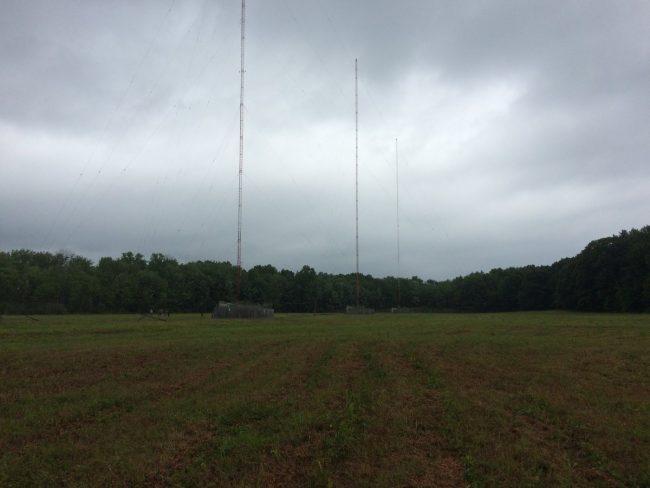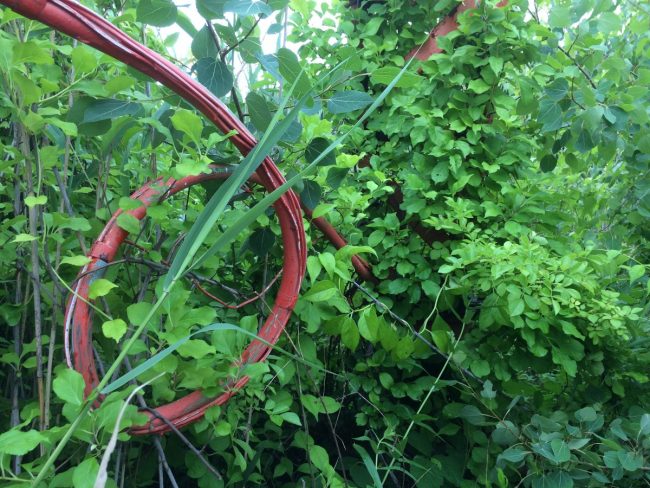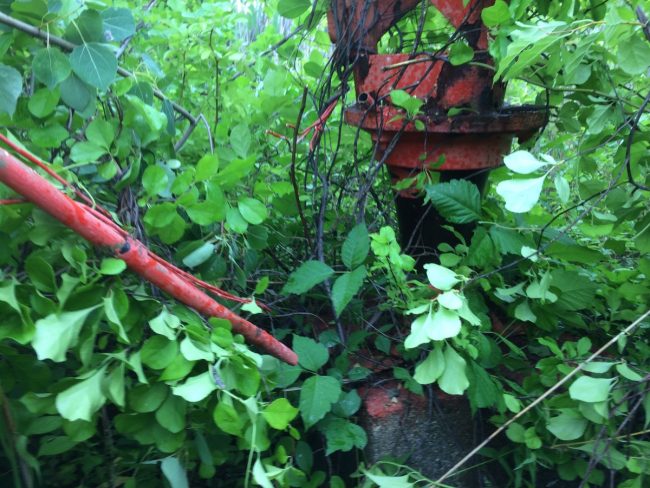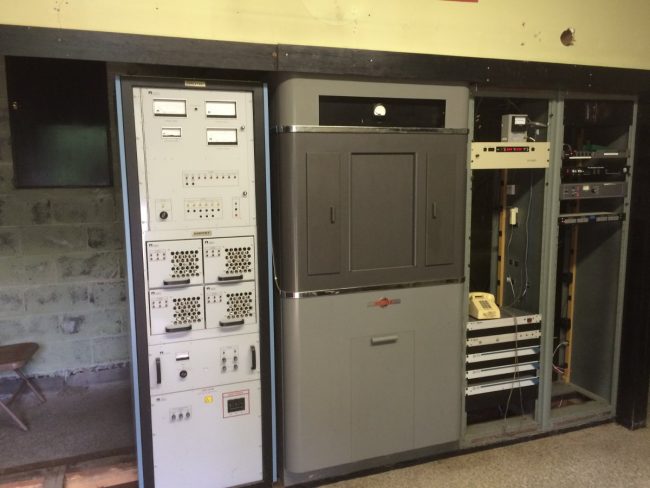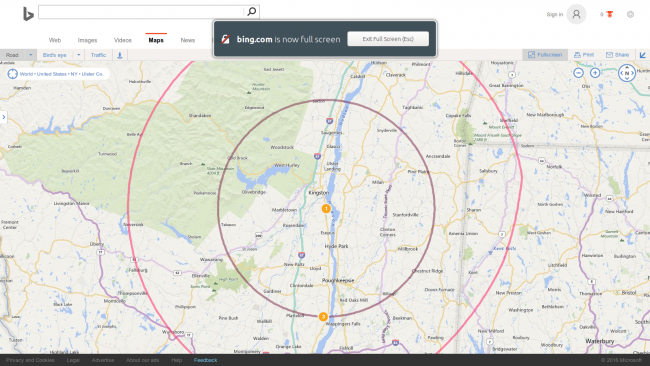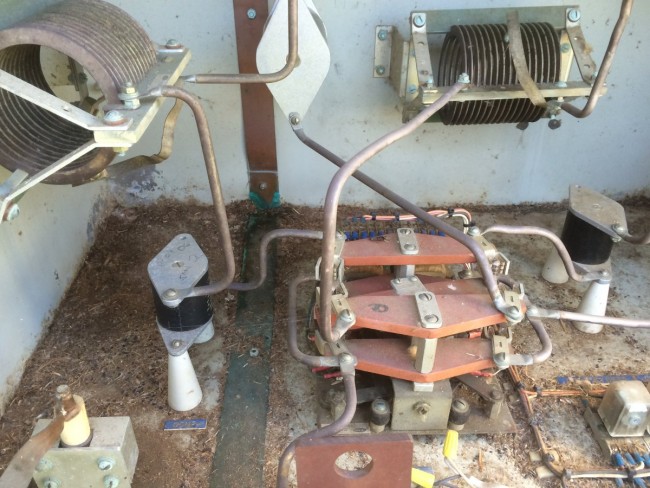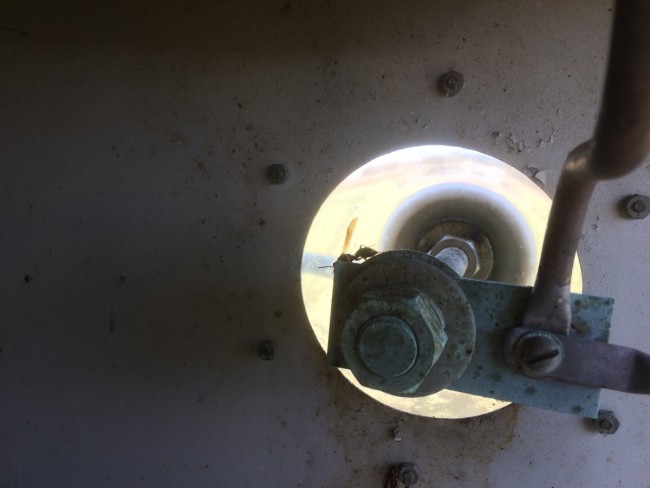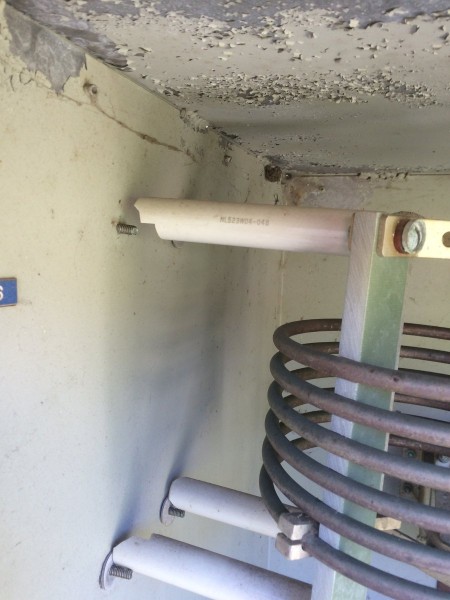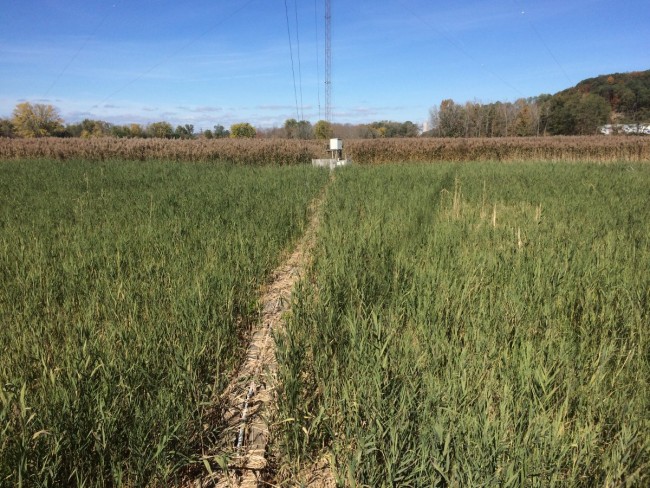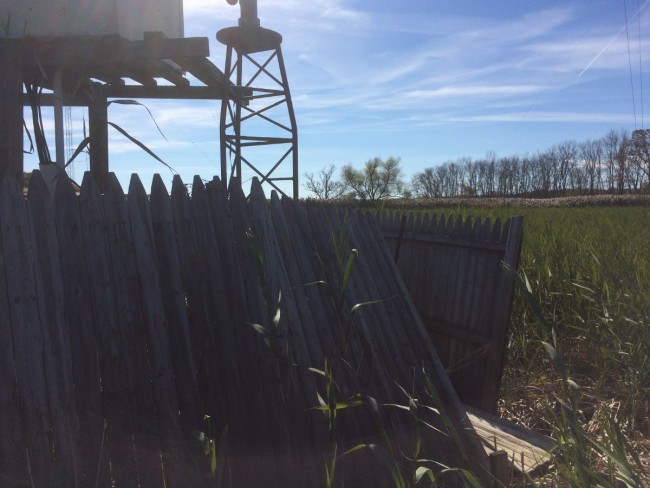This is a topic I have covered before, but it is worth doing it again for future reference. The previous post covered downgrading an AM transmission facility for WGHQ, Kingston, NY.
This is part II of that process.
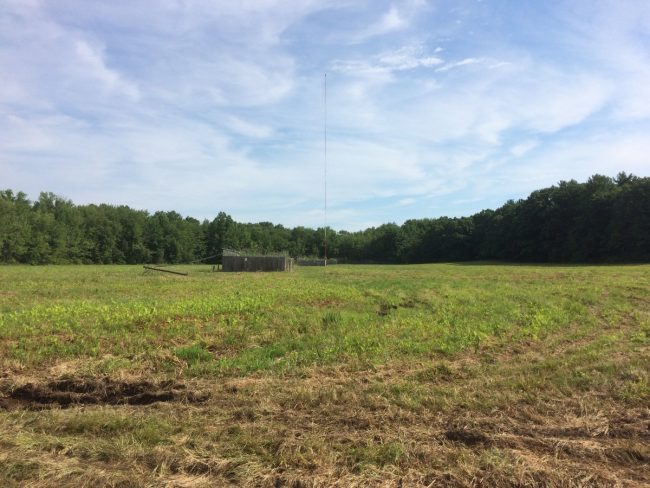
The old towers have been cut up and put in a scrap metal dumpster. They are off to China to be melted down and made into a submarine or a missile or a tank or something useful like that.

The directional array had three towers in a straight line with a common point impedance of 60 Ohms. Dropping two towers greatly changed the electrical characteristics of the remaining tower, therefore the existing ATU needed a bit of reworking to match the 50 Ohm transmitter output.
The first step, correct a few deficiencies left over from the old array.
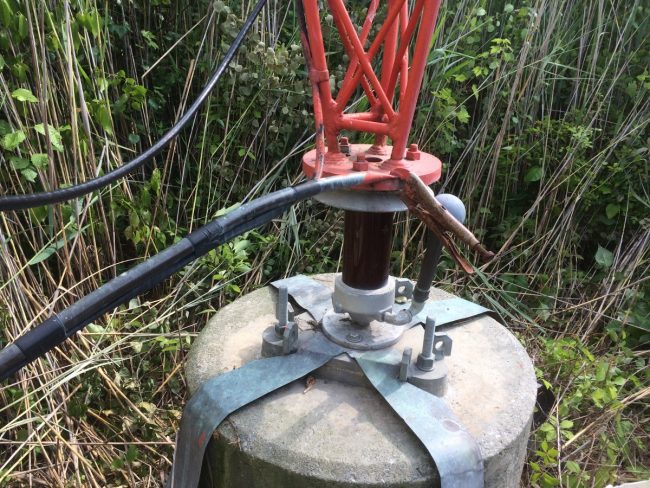
This vise-grip RF connection has to go. The problem is where the tower erectors attempted to solder the copper tubing. That tower base plate is pretty big and I would wager they didn’t use enough heat to make the solder connection. They were probably working in the winter time, thus the “temporary” fix. This tower was put up in 1993, so that temporary fix lasted 23 years.
I removed the offending tool and soldered the connection to another part of the tower with silver solder. The smaller crossbar made a good connection point.
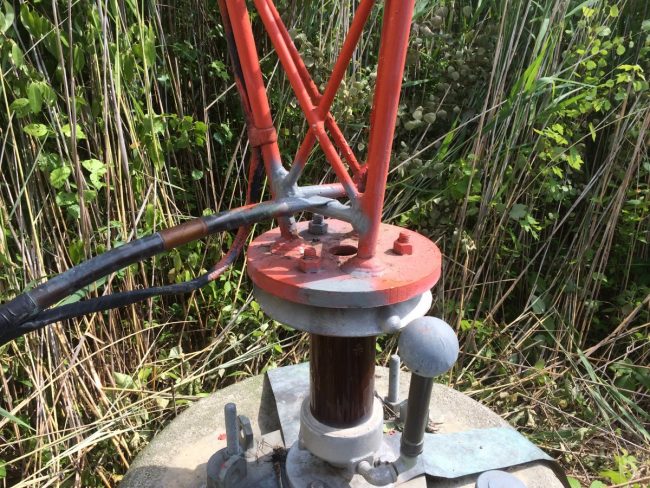
After soldering, I cleaned up and sprayed some grey primer on it to prevent rust from forming where I scraped the paint off.
Next, I made an impedance measurement:
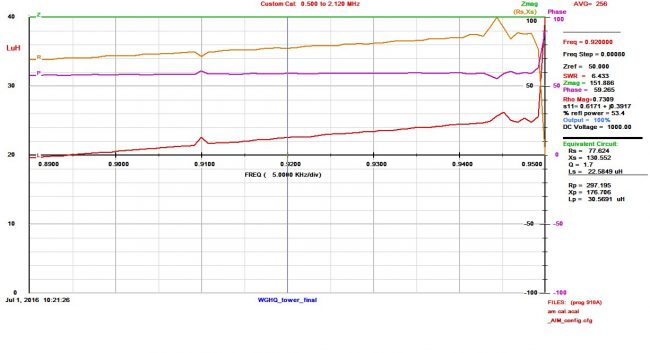
That junk on the upper part of the graph is coming from WHVW on 950 KHz. The tower itself looks pretty good, 77.6 Ohms resistance with 130 Ohms inductive reactance. Since this is not part of a directional antenna system, the ATU design is pretty straightforward. Given that WHVW on 950 KHz is located 10.41 miles away, a low-pass filter design is optimum. A basic low pass filter T network has inductive input and output legs with a capacitive shunt leg to ground.
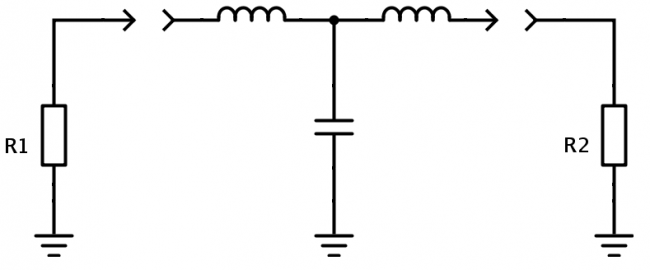
Each leg is used to match the 50 Ohm transmission line impedance (R1) to the 77.6 Ohm tower impedance (R2) and cancel out the 130 Ohms of inductive reactance. This is a vector impedance problem, much like a vector force problem in physics. Some basic arithmetic is required (always include the units):
X1, X2, X3 = √(Zin x Zout)
X1, X2, X3 = √(50Ω x 77.6Ω) or X = 62.28Ω
The value of inductance or capacitance for each leg is calculated using the basic inductance or capacitance formulas:
L (μH) = XL / 2πf(MHz)
And
C (μF) = 1 / 2πf(MHz) XC
Thus the input leg, or X1 = 62.28Ω / (6.28 x 0.92 MHz) or 10.78 μH
The Shunt leg, or X2 = 1 / (6.28 x 0.92 MHz x 62.28Ω) or .0028 μF
The output leg is a little different. The tower has 130 Ohms of inductive reactance that needs to be canceled out with a capacitor. Rather than cancel out all of the inductive reactance, then add an inductive output leg, the tower reactance can be used as part of the tuning circuit. The design calls for 62.28 Ohms inductive reactance, so 130Ω – 62.28Ω = 67.27Ω, which is the value needed to be canceled by a capacitor:
Output leg, or X3 = 1 / (6.28 x 0.92 MHz x 67.27Ω) or .0025 μF
A little Ohm’s law is used to calculate the base current for both the day and night time operations.
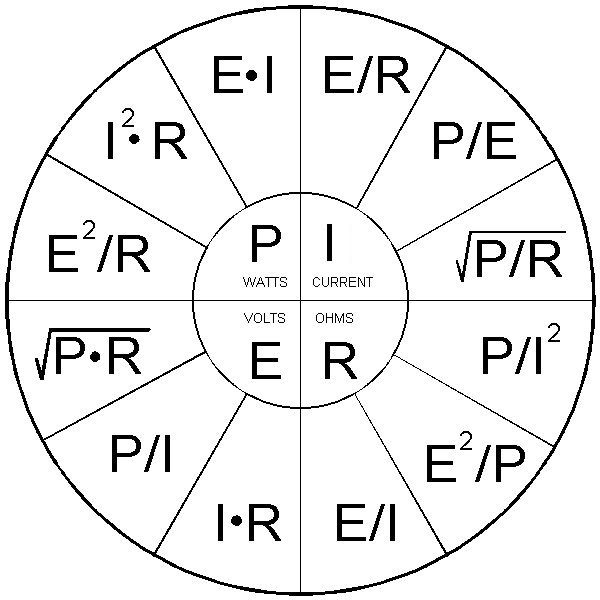
Thus the daytime base current is I = √(P/R) or I = √(1000 W/77.6Ω) or 3.58 Amps.
Night time base current is I = √(38 W/77.6Ω) or 0.70 Amps
Current handling requirements:
Base current is calculated to be 3.6 Amps at 1,000 Watts carrier power. Allowing for 125% peak positive modulation makes it 5.7 Amps. Having a safety factor of two or 11.4 Amps output leg and 14 Amps input leg.
Voltages: 353 maximum input voltage, 439 output.
Thus, 20 amp, 10 KV parts should work well.
The designed schematic for the ATU:
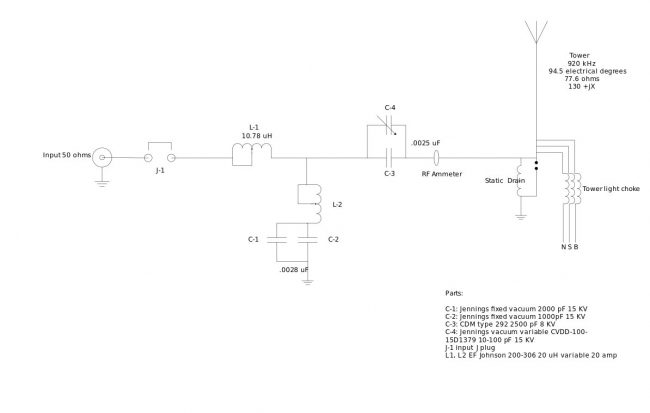
Putting it all together.
Since the tower looks fairly broad at 920 KHz, we are going to attempt a nice broadband ATU to match it. This station is currently programmed with a classic country format, and I have to tell you; those old Conway Twitty, Merle Haggard, Patsy Cline, et al., songs sound pretty good on the old AM radio. The Subaru stock radio has HD, which also has a nice broad IF section, thus allowing all those lovely mid-high-range frequencies through.
This is the existing ATU, which I believe was built by Collins in 1960:
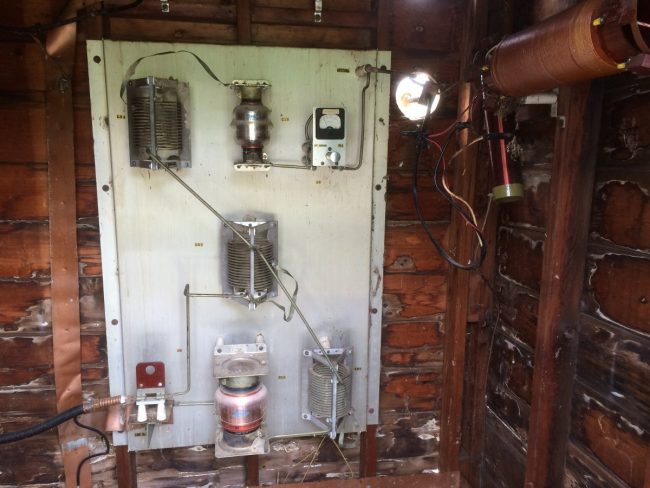
The ATU building is a little rough, but the ATU itself is in remarkable shape for being 56 years old. The input leg inductor is in the center and will be reused as is. The large Jennings vacuum capacitor at the bottom is a part of the shut leg. Its value is 2000 pF at 15 KV. The top vacuum capacitor is a series output cap, its value is 1000 pF at 15 KV. The basic plan is to move the upper cap down in parallel with the bottom cap. The shut leg inductor will be kept in place to tune out any access capacity. For the output leg, I have a 2500 pF mica cap and a 10-100 pF variable cap connected in parallel. The inductor on the output leg will be removed.
After some re-work on the ATU components, I tuned everything up. The easiest way to do this is to disconnect the legs, measure them individually, and adjust them for the desired reactance, which in this case is 62.28 ohms or thereabouts. The output leg was measured with the tower connected since the tower reactance is a part of the tuning circuit. The input leg was right about 10 μH. The shunt leg turned out to be about 0.002 μF. This is often the case, theoretical values are slightly different than field values due to stray capacitance and inductance in the connecting straps, etc.
This is the load, as measured at the output terminals on the transmitter:
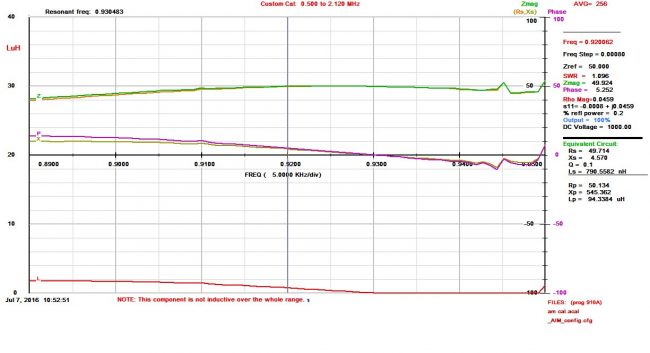
Slightly asymmetric on 910 KHz, but overall pretty good. There is a fair amount of phase rotation in the transmission line due to the length from transmitter to the tower (855 feet, 260.6 meter), which works out to be 0.93 wavelength allowing for the 86% velocity factor of the transmission line.
Time to pack up and go home.

